Table of Contents

Imagine a grain that boasts the nutritional punch of a superhero, the digestive comfort of a gentle giant, and the versatility of a culinary chameleon.
No, it’s not a figment of your imagination – it’s kamut, an ancient grain making a modern comeback for all the right reasons.
Forget the gluten woes and blandness of everyday wheat. Kamut, also known as Khorasan wheat, is its ancient, non-hybridized cousin.
Think of it as the wheat before the makeover, packed with the goodness nature intended.
So, what makes this golden grain such a nutritional rockstar?
Buckle up, because we’re about to embark on a journey through the Kamut kingdom.
General facts about Kamut :
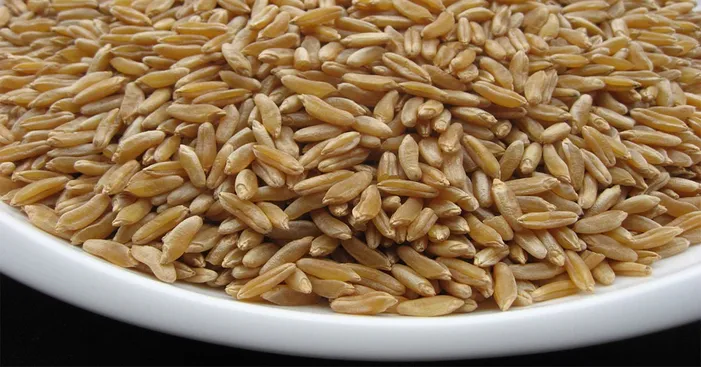
History:
More than just a type of wheat, Kamut is a living link to the past. Often called “Turanicum” or “Eastern Wheat,” its ancient lineage sets it apart.
Unlike modern wheat, Kamut has never been genetically modified, retaining its original characteristics and earning its place among the revered “Ancient Grains.”
But this isn’t just a claim to fame; it’s a tale whispered through time.
Some say Kamut’s story unfolds like a legend, unearthed from an Egyptian tomb, hinting at its presence alongside the pharaohs.
More likely, its roots lie in the sun-drenched lands of the Middle East, specifically the ancient Persian region of Kamut, meaning “where the sun originates.”
This fertile cradle, encompassing parts of modern-day Afghanistan, Iran, Uzbekistan, Turkmenistan, and Tajikistan, nurtured the giant grain long before it reached distant shores.
Kamut isn’t just ancient by name; it boasts a truly impressive stature.
Belonging to the Poaceae family, this “giant wheat” stands tall, with stalks reaching over 1.5 meters and ears stretching up to 15 cm.
The kernels themselves are a sight to behold: amber-hued and slightly curved, they’re nearly a third larger than their modern counterparts.
This striking contrast highlights the stark difference between Kamut, untouched by human intervention, and modern wheat, shaped by generations of selective breeding for yield and efficiency.
Kamut is more than just a relic; it’s a testament to the resilience of nature and the richness of our gastronomic heritage.
So, the next time you bite into a bread crafted from this ancient grain, remember, you’re not just savoring a delicious treat; you’re embarking on a journey through time, a taste of the ancient sun in every bite.
Difference between Kamut and common wheat:
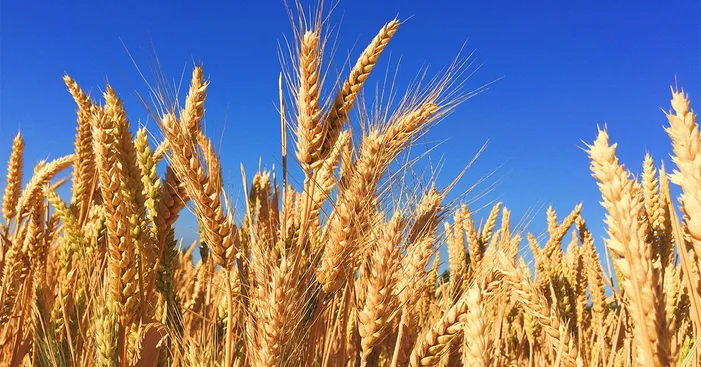
Kamut and common wheat, though close cousins in the grain family, share surprising differences.
While both serve as pasta’s foundation, kamut stands out with its oversized grains and reputation for being readily digestible.
But delve deeper, and you’ll discover even more remarkable contrasts.
Protein powerhouses? Kamut takes the crown.
Packing nearly 15 grams per 100 grams, it boasts almost 40% more protein than its counterpart, providing valuable fuel for healthy muscles – a fact backed by research in the scientific journal Nutrients.
Vitamin content also sees a shift, with kamut offering a brighter edge.
Abundant in vitamin A, this grain holds the potential for safeguarding our vision, particularly against macular degeneration.
When it comes to carbs, things get interesting.
Though the total carbohydrate load might be similar, Kamut’s gentle touch on blood sugar sets it apart.
Generating a lower glycemic peak avoids the sharp spikes associated with refined wheat – a common culprit in fluctuating blood sugar levels.
So, while both kamut and common wheat have their place in the pantry, understanding their unique strengths paves the way for informed choices.
Whether seeking a protein boost, visual protection, or a gentler carb ride, kamut might just become your grain of choice.
Kamut nutritional values and health benefits:
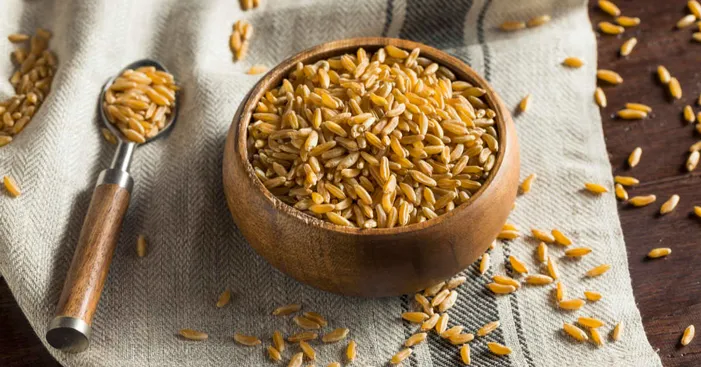
Nutritional values:
These data count for 3.5 oz (100 g) of raw Kamut:
- 3% protein.
- 6% fat.
- 2% carbohydrates.
- 8% of fibre.
- 31 mg of calcium.
- 446 mg of potassium.
- 153 mg of magnesium.
- 4,2 mg of iron.
- 0,46 mg copper.
- 8 mg of sodium.
- 411 mg of phosphorus.
- 3,2 mg manganese.
Health benefits:
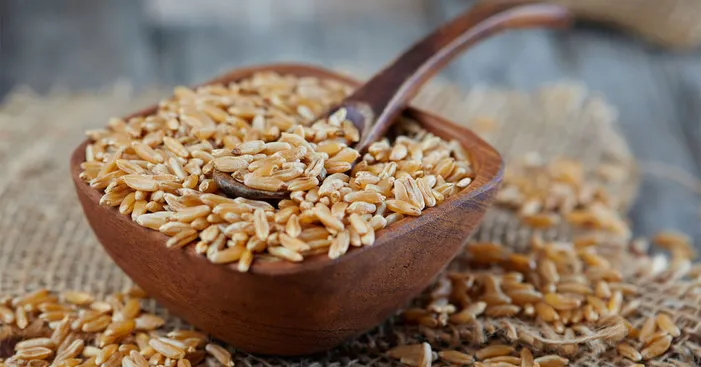
Improves intestinal health:
Kamut stands out for its rich fiber content, a champion for gut health.
Its abundance of insoluble fiber helps keep things moving smoothly, preventing constipation and potentially lowering colon cancer risk, as confirmed by a study in the International Journal of Food Sciences and Nutrition.
But don’t forget the diversity of fiber’s goodness!
While Kamut excels in insoluble fiber, other grains like oats, boasting beta-glucans (a type of soluble fiber), perfectly complement its gut-loving benefits.
By incorporating a variety of fiber-rich grains into your diet, you’re giving your intestinal health the ultimate all-star team to thrive on.
Full of antioxidants:
Beyond its familiar role in maintaining good vision, the ancient grain Kamut packs a powerful punch when it comes to overall health.
Its secret weapon? A rich content of vitamin A.
This crucial nutrient plays a double duty, acting as a shield against both free radicals and inflammation.
Studies, like one published in Nutrition and Health, have even linked sufficient vitamin A intake to a reduced risk of liver pathologies.
So, if you’re looking for a delicious way to boost your antioxidant defenses and protect your body from inflammatory stress,
Boosts the immune system:
Kamut shines not only for its delicious nutty flavor and hearty texture but also for its impressive nutrient profile.
One standout micronutrient is zinc, essential for both the proper functioning of the immune system and the regulation of testosterone production in men.
By ensuring we get enough zinc through our diet, we can bolster our body’s natural defenses against infectious diseases, making kamut a valuable contributor to our overall health and well-being.
Offers energy:
Whether you’re fueling for a marathon or simply powering through your daily routine, carbohydrates deserve a starring role on your plate.
For athletes, they ignite the explosive power of anaerobic metabolism, driving those hard-earned bursts of exertion.
But even if your days lack competitive sprints, carbs needn’t be demonized.
The key lies in choosing wisely and understanding quantity.
Opt for low-glycemic index carbs, which digest gradually, providing sustained energy without the dreaded sugar crash.
So, whether you’re a weekend warrior or a weekday walker, embrace the power of carbs, chosen the right way, to keep your body humming happily.
Regulates cholesterol:
While diet’s impact on cholesterol isn’t as significant as often believed, fiber, particularly from sources like kamut, can still contribute to a healthier overall lipid profile.
This includes a modest reduction in “bad” LDL cholesterol.
However, it’s important to remember that low cholesterol isn’t the only goal.
Focusing solely on lipid levels as a marker of cardiovascular health is an outdated approach.
Unless your cholesterol is dangerously high, a nuanced understanding that factors beyond just a single number play a role is crucial.
Precautions before you consume Kamut:

Kamut, an ancient wheat variety prized for its dense nutrient content, generally boasts a clean bill of health.
While it’s well-tolerated by most, it’s not entirely without potential downsides. Consuming large quantities might lead to some digestive discomfort, like bloating or gas.
However, for regular, moderate consumption, there’s little to worry about.
In fact, its superior nutritional profile, packed with protein, fiber, and essential minerals, often earns it a recommendation from health professionals.
But one caveat remains: those with gluten intolerance, while likely experiencing less severe reactions compared to regular wheat, should still steer clear of kamut as it does contain gluten, albeit in smaller amounts.
So, while kamut generally shines as a nutritious and well-tolerated grain, responsible consumption and awareness of potential sensitivities are still key.
Using Kamut:
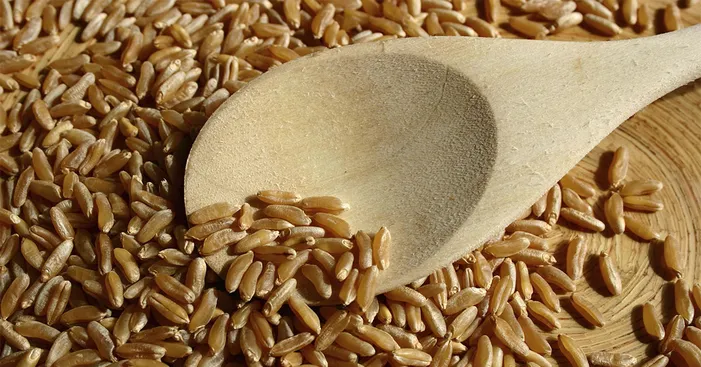
Craving a nutty, buttery boost to your bread, pasta, or pancakes?
Look no further than kamut, an ancient wheat variety packed with flavor and whole-grain goodness.
You’ll find it nestled amongst the cereals and flours at your local health food store, or conveniently delivered to your door through online retailers.
Don’t be fooled by its ancient heritage, kamut works just like modern wheat.
Bake up bread as fluffy as clouds, knead pasta bursting with flavor, or whip up crispy waffles and pancakes for a breakfast fit for royalty.
This versatile grain even lends its unique character to craft beers!
To unleash kaput’s full potential, a quick overnight soak works wonders.
But hey, life happens! Skip the soak if you’re short on time, just be prepared for a slightly longer simmer.
Simply combine one cup of Kamut with three cups of water in a medium or large saucepan, bring it to a lively boil, then lower the heat and simmer for 30-40 minutes (soaked) or a full hour (unsoaked) until the kernels are tender and ready to elevate your culinary creations.
Kamut is suitable for different diets:
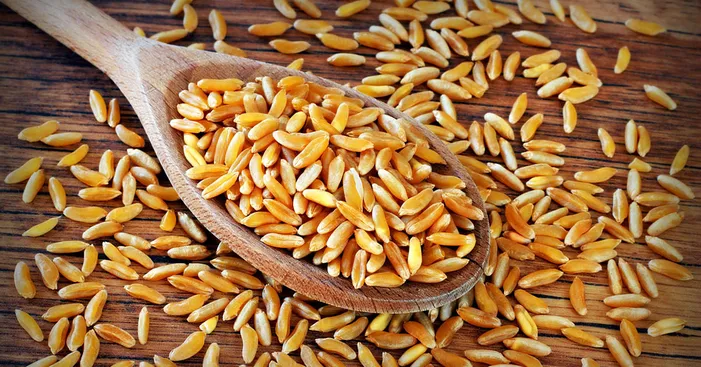
Kamut, an ancient grain with a modern appeal, packs a powerful punch when it comes to nutrition.
It’s a protein powerhouse, boasting a higher protein content than most other grains, making it an ideal ally for vegetarians and vegans seeking complete amino acid profiles.
Rich in minerals like zinc and magnesium, Kamut also contributes to optimal bodily function.
However, its suitability for different diets requires some nuance.
While not technically gluten-free, Kamut contains a different form of gluten than modern wheat varieties.
This variation may be tolerated by some individuals with gluten sensitivities, but for those with celiac disease, it’s best to stick to naturally gluten-free grains like teff.
For those managing type 2 diabetes, Kamut shines with its low glycemic index.
This means it releases sugar into the bloodstream slowly, helping maintain stable blood sugar levels.
Soaking Kamut before cooking further enhances its digestibility and unlocks its subtle, nutty flavor.
Remember, like any dietary change, introducing Kamut should be done gradually.
This allows your body to adjust to its unique fiber content and avoid potential digestive discomfort.
So, whether you’re a health-conscious foodie, a vegetarian seeking diverse protein sources, or someone managing diabetes, consider giving Kamut a try.
Embrace its ancient wisdom and savor its modern nutritional benefits!
Buying Kamut:

Embarking on a journey into the world of Kamut?
Hold on!
Before you snag the first bag you see, consider this.
This ancient grain comes in a dazzling array of forms: whole, ground, and even hiding in bread and pasta. But for the ultimate nutritional punch, stick to the OG – whole, unprocessed kamut.
Organic is your best bet here, steering clear of any unwanted pesticide guests.
And don’t forget to be a freshness detective – newer kamut packs more nutritional perks.
Watch out for sneaky imposters, though. Some products mix kamut with less stellar refined cereals, so read those labels like a pro.
Storing Kamut:
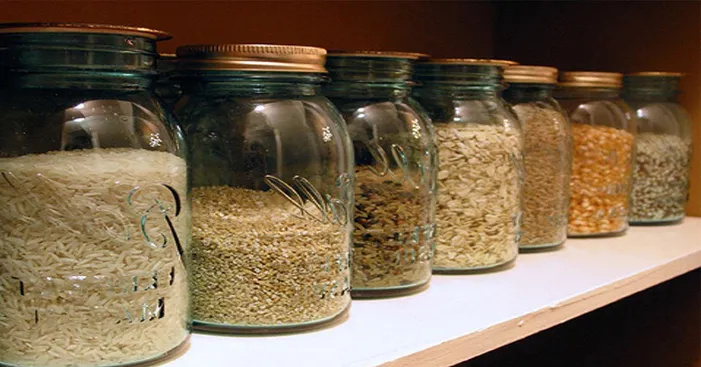
Finding the perfect haven for your leftover kamut seeds is crucial for future garden adventures.
Don’t let their slumber turn into eternal rest! Keep these tips in mind:
Banish germination triggers:
Avoid warm corners, sunbeams, and damp patches. Seek out a cool, dry, and shadowy retreat.
Think metal or natural wood boxes tucked away in the cellar, far from the solvent fumes of chipboard furniture.
Embrace air-tight havens:
Plastic boxes or glass jars with tight lids make fantastic seed fortresses.
Tuck a silica sachet (those little packets found in shoe boxes and electronics) inside to absorb any cheeky moisture that might sneak in.
Fridge, anyone?
Just remember, the temperature change can cause condensation, so the silica will be your moisture-munching hero.
Repurpose with care:
No fancy containers? No problem! Get creative with small cardboard boxes, pill bottles, or even empty jam jars.
If paper envelopes are your jam, remember to choose chlorine-free options and nestle them snugly inside a metal cookie tin for extra protection.
Label wisely:
Don’t let your seeds play a game of mystery!
Clearly label them with the variety name and the year of harvest.
Future you will thank you for the clarity when springtime rolls around.
With these tips, your seeds will rest comfortably, awaiting their moment to burst forth and bring your garden to life again.
Happy storing!
